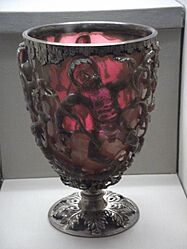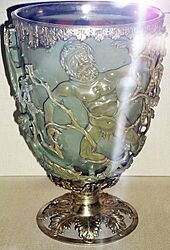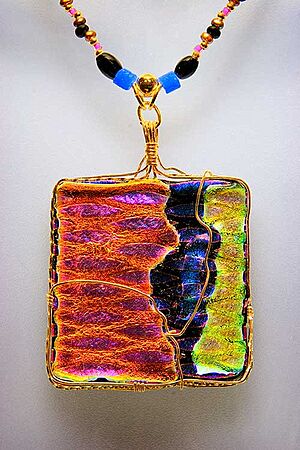Dichroic glass facts for kids
Dichroic glass is a special type of glass that can show many different colors. The colors you see depend on how the light hits the glass and from what angle you look at it. It's like magic, but it's all about science!
There are two main kinds of dichroic glass. One is a modern type made by adding super-thin layers of metal to glass. These layers make the glass shimmer with changing colors, almost like a rainbow. This kind of glass is often used for cool art, stained glass windows, and shiny jewelry. Sometimes, it can even show three or more colors, which is called "trichroic."
The other kind of dichroic glass is much older. It first appeared in some Roman glass pieces from about 1,600 years ago. This ancient glass has tiny bits of gold and silver mixed into it. These tiny particles make the glass look one color when light shines through it, and a completely different color when light reflects off it. The most famous example is the 4th-century Lycurgus cup. When light shines on the front, the cup looks green. But if you shine a light from inside or behind it, the cup turns a beautiful purplish-red!
Contents
How Dichroic Glass Was Discovered
 |
 |
| The amazing Lycurgus cup shows different colors depending on how the light hits it. | |
Modern dichroic glass was developed by NASA and its partners. They created it for special filters used in space technology.
But the idea of glass changing colors is very old. As you read, the Romans made it in the 4th century AD. Only a few pieces of this ancient glass still exist today. Later, during the Renaissance in Venice, people also made color-changing glass. These pieces are also very rare and special.
Making Modern Dichroic Glass
To make modern dichroic glass, scientists use a special process. They put glass into a vacuum chamber, which is a space with no air. Then, they use a powerful electron beam to heat up tiny pieces of metals like titanium, chromium, aluminium, zirconium, or magnesium. They also use silicon dioxide, which is like super-fine sand.
When these materials get hot enough, they turn into a vapor, like steam. This vapor then settles onto the surface of the glass, forming many super-thin layers. Imagine painting a glass with 30 to 50 layers, but each layer is thinner than a human hair! The total coating is only about 760 to 890 nanometers thick. That's incredibly thin!
Sometimes, a protective layer of quartz crystal is added on top. By carefully controlling how thick each layer is, different amazing colors can be created. The way light bounces off and passes through these many layers is what makes the glass change colors.
Artists can even remove parts of the dichroic coating. They often use a laser to do this. This allows them to create cool patterns, letters, animals, or even faces on the glass.
Cool Uses for Dichroic Glass
Dichroic glass is used in many interesting ways, from science to art and even buildings!
Art and Jewelry
Many glass artists love working with dichroic glass. They often call it "dichro" for short. Artists can heat and shape the glass, then fuse it together to make unique sculptures. They can also add the dichroic coating to glass pieces after they've been shaped. This makes each piece of art truly one-of-a-kind, with its own special color changes.
Buildings and Architecture
Dichroic glass is also used to make buildings look amazing. For example, the Amazon Tower I in Seattle, Washington, has dichroic glass on its outside. This makes the building reflect light in different colors throughout the day. It looks different depending on the time and weather!
Another great example is the Museum at Prairiefire in Overland Park, Kansas. This museum has a striking glass exterior that changes color with the light. The design was inspired by the prairie fires that are part of farming life in Kansas. The museum itself becomes a work of art because of its shifting, vibrant colors.


